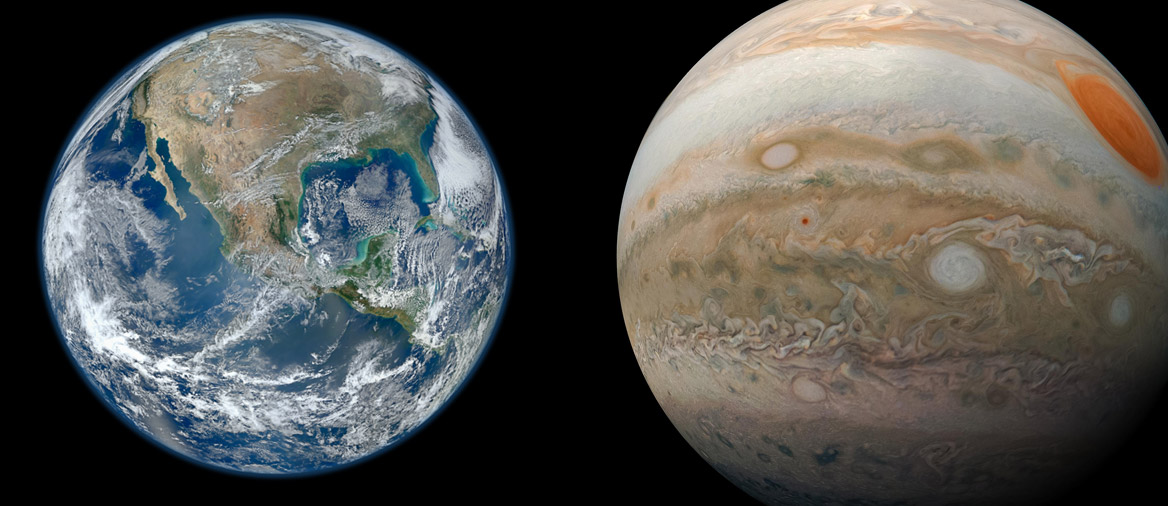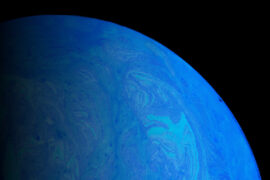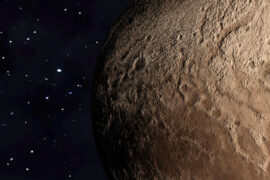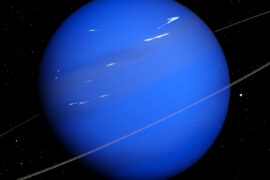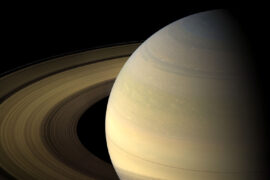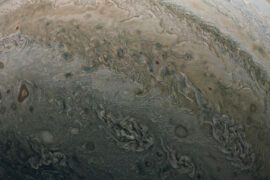Jupiter is the biggest planet in the Solar system and is located more than 872 million kilometers (542 million miles) away from Earth. What could these two planets possibly have in common?
Well, as it turns out, a lot.
All the planets in the Solar system shared some similarities right from the start. However, they did evolve in very different paths to become as different as they are today.
In this article, we’ll compare Earth and Jupiter and take a look at the differences and similarities. This will help us get a better understanding of our own planet and its place in the Solar system.
Earth vs Jupiter comparison
| Earth | Jupiter | |
|---|---|---|
| Position in the Solar system | 3 | 5 |
| Distance from the Sun (avg) | 150 million km | 741 million km |
| Radius | 6,371 km | 69,900 km |
| Mass | 5.97237×1024 kg | 1.9 × 1027 kg |
| Rotation period (1 day) | 24 hours | 10 hours |
| Rotation speed | 0.46 km/s | 45,000 km/h |
| Orbit period (1 year) | 365 days | 11.85 years |
| Orbital speed | 29.78 km/s | 13.07 km/s |
| Average temperature | 14 °C | −110 °C |
| Surface pressure | 101.325 kPa | 200 – 600 kPa |
| Surface gravity | 9.8 m/s2 | 24.79 m/s2 |
| Density | 5.52 g/cm3 | 1.33 g/cm3 |
| Escape Velocity | 11.18 km/s | 59.5 km/s |
| Albedo | 0.367 | 0.5 |
| Satellites (Moons) | 1 | 95 |
| Core | rock | rock, metal, ice |
| Atmosphere | 78% N, 21% O | 89% H, 10% He, 0.3% CH4, traces of others |
Earth vs Jupiter size comparison
The difference in size between Earth and Jupiter is enormous. Jupiter’s radius is almost 11 times that of Earth’s. In terms of volume, this means that you could fit over 1,300 planets the size of Earth into one Jupiter.
Jupiter is the biggest planet in the Solar system. Earth is the fifth largest, considerably behind all the gas giants (Jupiter, Saturn Uranus, and Neptune).
The following image shows a scaled comparison of the size difference so you can get a better idea of what this means.
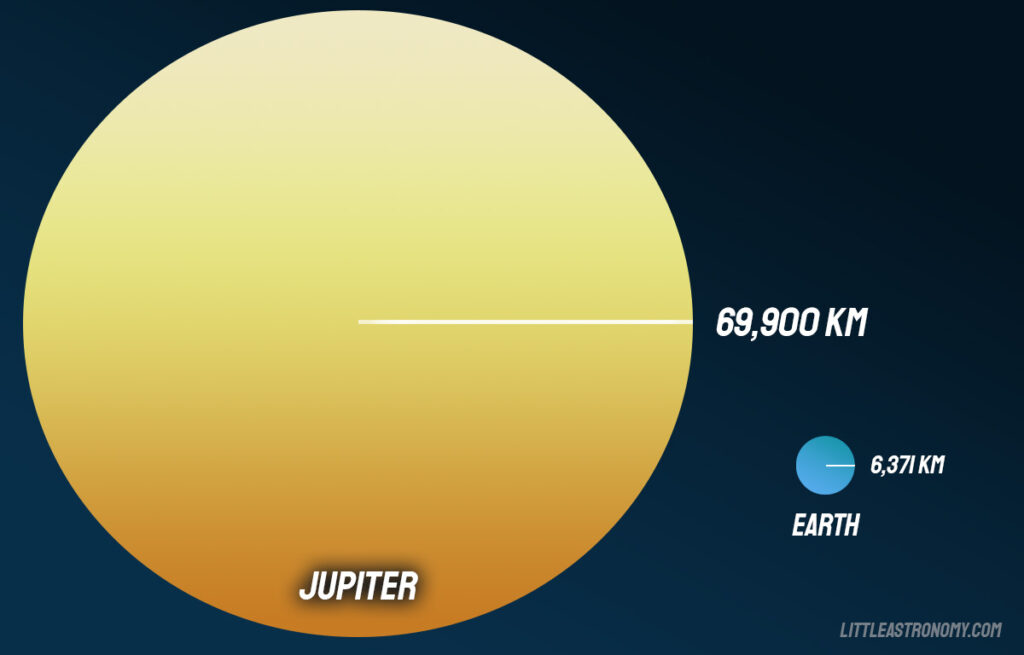
Earth and Jupiter similarities
- Both planets are in the Solar system and orbit around the Sun
- Both planets are spherical despite one being rocky and the other being mostly made out of gas
- Both planets have cleared their orbits of any other large objects
- Both planets formed around the same time, 4.5 billion years ago.
- Earth and Jupiter rotate in the same direction, counter-clockwise.
- Jupiter and Earth are the biggest planets of their planetary classifications. Jupiter is the largest of the gas giants and Earth is the largest of the terrestrial planets.
- Likewise, Jupiter and Earth have the biggest magnetic fields of their planetary classifications. Jupiter has the biggest out of all the gas giants, and Earth out of all the terrestrial planets.
- Both planets have atmospheres.
- Both planets experience storms. As a matter of fact, storms in Jupiter can last for a long time. Its famous “red giant dot” is a storm that has been raging for centuries.
- Earth and Jupiter both have natural satellites, or moons as we commonly call them.
- Jupiter also has auroras like the aurora borealis (northern lights) that are visible close to the poles on Earth.
Earth and Jupiter differences
- The most obvious difference between Earth and Jupiter is their size. Jupiter’s diameter is almost 11 times bigger than Earth’s. That means that you could fit about 1,3000 Earths in one Jupiter.
- Jupiter rotates much faster than Earth. Despite its large size, Jupiter completes one rotation (one day) in just 10 hours.
- On the other hand, Earth travels through its orbit much more than twice as fast as Jupiter. Combined with Jupiter’s longer orbit, this means that one year in Jupiter is more than 11 Earth years.
- Earth is a rocky planet with a solid surface. Jupiter is made out of gas and doesn’t have a surface to stand on. This is why it is referred to as a “gas giant”.
- Jupiter is much colder than Earth because it is so far away from the Sun. The average temperature in Jupiter’s outer layers is −185°C (-301°F)
- Earth and Jupiter’s cores are quite different. Not just in composition, but we don’t know for sure yet if Jupiter even has a solid core.
- Earth is the densest planet in the Solar system. Jupiter is the second least dense planet. Only Saturn is denser.
- Because of its higher gravitational pull, it would take a spaceship about 5 times as much speed to escape Jupiter than Earth. The rockets would have to be much more powerful.
- Jupiter has A LOT more natural satellites than Earth. The current count is at 95 moons but this number has been rapidly increasing over the last few years as more of them are discovered.
- The composition of Jupiter’s and Earth’s atmospheres is very different. Earth’s is mostly made up of nitrogen and oxygen and Jupiter’s is hydrogen and helium.
- Earth looks blue, white, brown, and green from space. Jupiter’s dominant colors are light yellow, orange, and brown.
- Jupiter has rings like Saturn, they are just much thinner and smaller. Earth doesn’t have any rings.
- Jupiter is almost exactly 5 times farther away from the Sun than Earth.
Summary
- Earth and Jupiter formed at the same time as the rest of the planets but took very different paths throughout billions of years of history.
- Some of the similarities between Earth and Jupiter include the direction of their rotation, weather characteristics, and that they are the biggest planets of their categories.
- The differences between Aerth and Jupiter are size, composition, number of moons, and density, amongst others.

